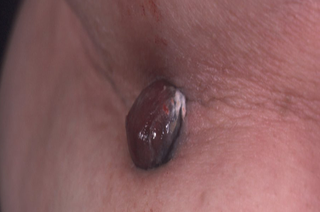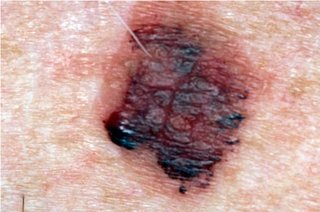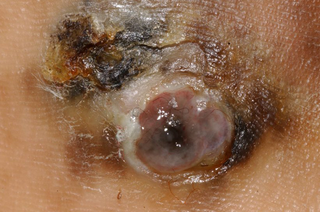There are 2 main types of skin cancer - melanoma skin cancer and non-melanoma skin cancer.
Melanoma skin cancer is much less common than non-melanoma skin cancer. But it has become more common in Ireland in recent years. About 1,100 people are diagnosed with melanoma skin cancer each year.
It is more common in people over 50, but you can get it at any age.
Melanoma skin cancer starts in cells in skin called melanocytes. It can spread to other organs in the body.
Signs and symptoms of melanoma
The most common sign of melanoma is a new mole or a change in an existing mole. A mole may change shape, size or colour. It may stand out among other moles.
Most melanomas are new moles.
Check your skin every few months for new moles or changes in existing moles. Spot any changes using the ABCDE of moles.
Types of melanoma
There are many different types of melanoma. Sometimes melanoma skin cancer is called malignant melanoma.
Non-urgent advice: Contact your GP if:
you are worried about any moles or skin changes

About 7 in 10 melanomas are superficial spreading melanomas. They're more common in people with white skin and freckles.
Superficial spreading melanomas tend to grow along the surface of your skin rather than downwards. But if they grow downwards into the deeper layers of skin, they can spread to other parts of your body.
Nodular melanoma

Nodular melanomas are fast growing. If they are not removed, they can quickly grow downwards into the deeper layers of your skin.
Nodular melanomas usually appear as a changing, raised lump on the skin. They might be black or red. They most often appear your head, neck, chest or back. The lump often bleeds or oozes.
Lentigo maligna melanoma

About 1 in 10 melanomas is a lentigo maligna melanoma. These melanomas are most common in people age 65 and over. They can happen if you've spent a lot of time outdoors. They develop slowly over years and appear in areas that are often exposed to the sun, such as your face and scalp.
Lentigo maligna melanomas are flat and brown. They develop sideways in the surface layers of skin. They look like a freckle but are usually larger, darker and stand out more. They can gradually get bigger and may change shape. At a later stage, they may grow downwards into the deeper layers of skin and can form lumps (nodules).
Acral lentiginous melanoma

Acral lentiginous melanomas are rare. You usually get them on your hands and feet. They can also develop around a nail, most often your thumbnail or big toenail.
Acral lentiginous melanomas are the most common type of melanoma in people with black or brown skin. But they can occur in people with any skin type.
Amelanotic melanoma
Amelanotic melanomas are rare. They usually have little or no colour. But sometimes they are pink or red, or have light brown or grey edges.
What causes melanoma?
Most melanomas are caused by exposure to ultraviolet (UV) light from the sun or a sunbed.
Certain things can increase your chances of developing melanoma, such as having:
- lots of moles or freckles
- pale white skin that burns easily and never tans
- red or blonde hair
- a close family member who has had melanoma
Diagnosing melanoma
Non-urgent advice: Contact your GP if:
- you notice a new or changing mole
If they think you have melanoma they'll refer you to a pigmented lesion clinic or a rapid access skin cancer clinic. These are located around the country.
In most cases, a suspicious mole will be surgically removed and examined to see if it's cancerous.
Treating melanoma
The main treatment for melanoma is an operation (surgery). But your treatment will depend on things like the stage of the cancer and your general health.
If melanoma is diagnosed and treated at an early stage, surgery is usually successful.
Preventing melanoma
Melanoma is not always preventable, but you can reduce your chances of developing it by avoiding getting sunburnt.
You can help protect yourself from the sun by:
- covering up with a hat, clothing and sunglasses
- staying in the shade, especially between 11am and 3pm
- putting sunscreen on any skin that is not covered
Do not use sunbeds, sunlamps or sunbathe.
Content supplied by the NHS and adapted for Ireland by the HSE
